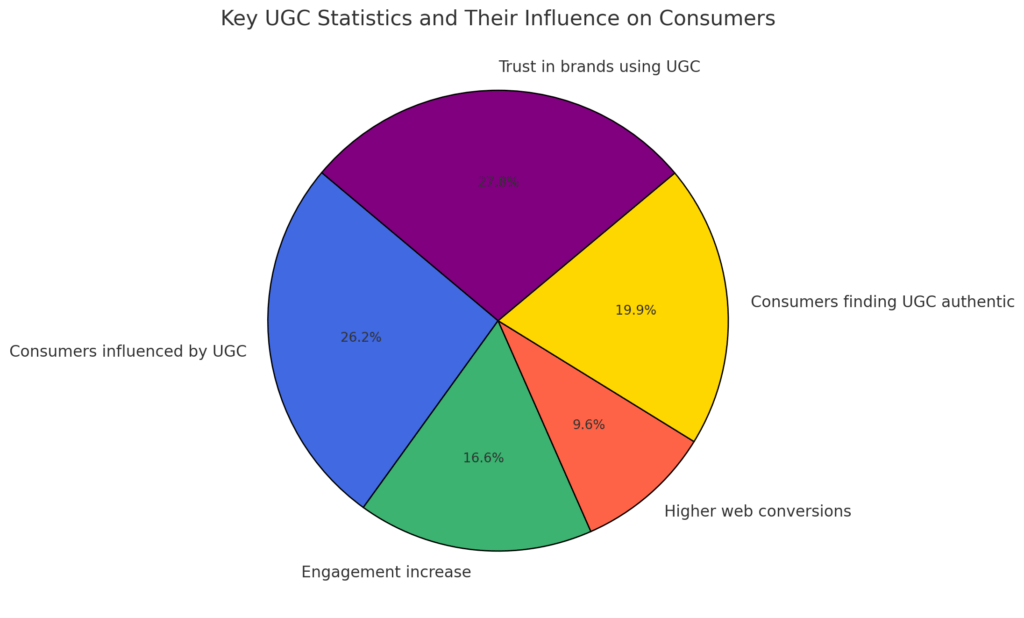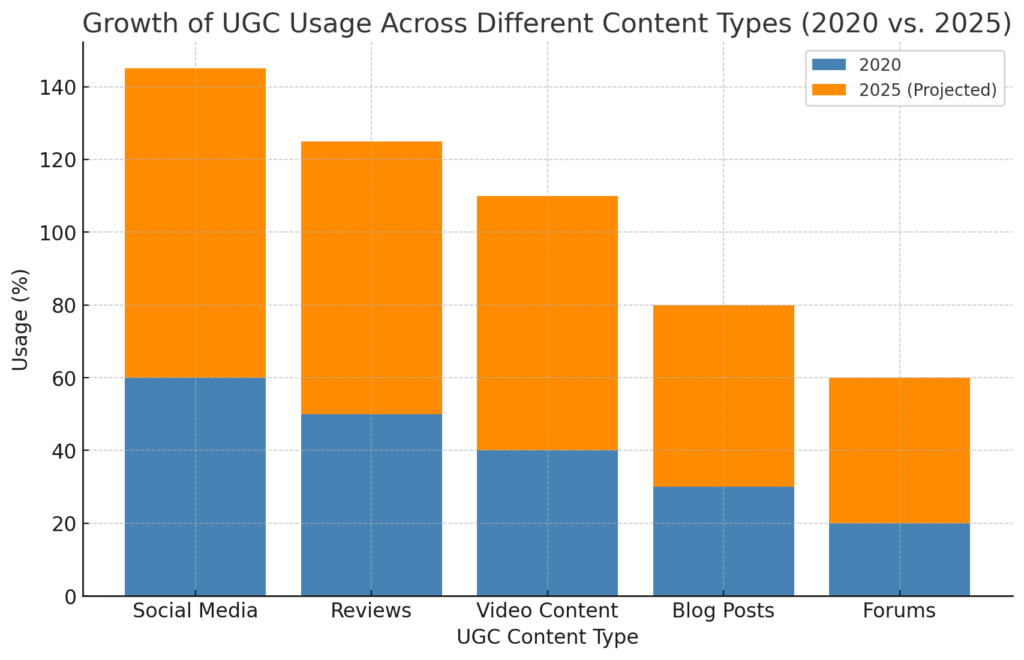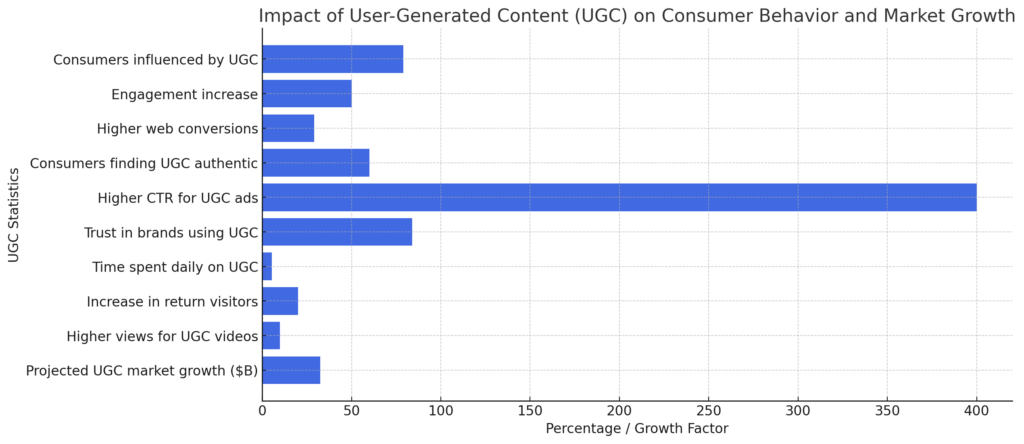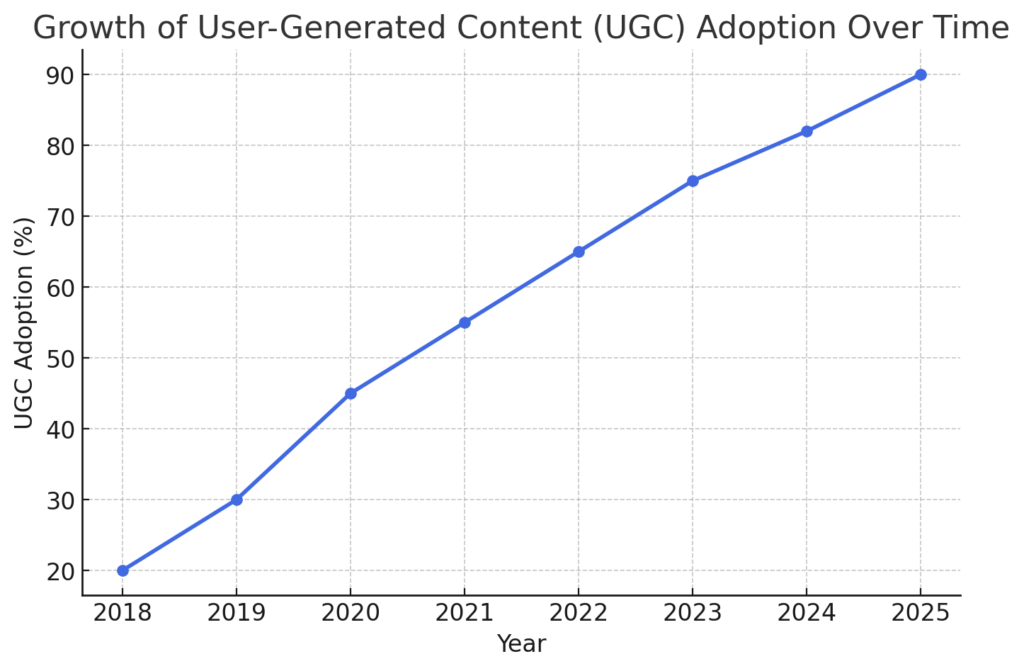
18 Mar USER-GENERATED CONTENT STATISTICS 2025
User-generated content (UGC) has transformed digital marketing, shaping consumer trust, engagement, and purchasing behavior. As brands move away from traditional advertising, peer-created content is proving to be more influential, cost-effective, and credible. With social media, AI, and new digital platforms accelerating this shift, UGC is now at the core of brand storytelling, community-building, and conversion strategies. Amra and Elma presents the statistics below to highlight the power of UGC, showcasing its impact on brand performance and consumer decisions. These insights not only reveal the effectiveness of UGC today but also predict its growing role in the future of marketing. As AI-driven personalization and social commerce evolve, brands that embrace authentic, user-driven content will stay ahead. Understanding these trends is essential for businesses looking to build trust, engage audiences, and drive long-term success in the digital space.
USER-GENERATED CONTENT STATISTICS 2025 (Editor’s Choice)
User-generated content (UGC) has become a pivotal element in modern marketing strategies, influencing consumer behavior and brand perception. Here are 20 insightful statistics highlighting the significance and impact of UGC over time and projections for 2025:
1. Influence on Purchasing Decisions: 79% of consumers report that UGC highly impacts their purchasing decisions.
2. Trustworthiness: 84% of people are more likely to trust a brand if it uses UGC in its marketing campaigns.
3. Engagement Rates: Social media campaigns incorporating UGC see a 50% increase in engagement.
4. Conversion Rates: Brands utilizing UGC experience a 29% higher web conversion rate compared to those that don’t.
5. Content Authenticity: 60% of consumers believe UGC is the most authentic form of content.
6. Advertising Effectiveness: UGC-based ads achieve 4 times higher click-through rates and a 50% reduction in cost-per-click.
7. Consumer Trust: 93% of consumers find UGC helpful when making purchasing decisions.
8. Time Spent: Consumers spend an average of 5.4 hours daily engaging with online content, specifically UGC.
9. Brand Loyalty: 75% of marketers claim that UGC makes the brand more authentic, fostering brand loyalty.
10. Millennial Influence: Millennials find UGC 35% more memorable than other media and trust it 50% more.
11. Gen Z Engagement: 35% of Gen Z believes UGC will be more credible in the next 3-5 years.
12. Email Marketing: Incorporating UGC in email marketing drives a 78% higher click-through rate.
13. SEO Benefits: 25% of search results for the world’s biggest brands are links to UGC.
14. Video Content: User-generated videos on YouTube receive 10 times more views than brand-produced content.
15. Return Visitors: Websites featuring UGC see a 20% increase in return visitors.
16. Time on Site: Visitors spend 90% more time on websites that include UGC.
17. Content Creation: 86% of companies today use UGC as part of their digital marketing strategy.
18. Market Growth: The global UGC content market is projected to grow from $5.36 billion to $32.6 billion by 2030.
19. TikTok Effectiveness: UGC on TikTok is 22% more effective than branded content.
20. Future Projections: By 2033, it’s anticipated that 78% of online content will be user-generated.
These statistics underscore the growing importance of user-generated content in shaping consumer behavior, enhancing brand authenticity, and driving marketing success.

USER-GENERATED CONTENT STATISTICS 2025 and Future Implications
USER-GENERATED CONTENT STATISTICS 2025 #1. Influence on Purchasing Decisions (79%)
User-generated content (UGC) plays a major role in shaping consumer purchasing behavior, with nearly 79% of consumers admitting its strong influence. This means brands that fail to incorporate UGC into their marketing may struggle to connect with their audience effectively. The authenticity and relatability of UGC make it more persuasive than traditional advertising, which is often viewed with skepticism. Looking ahead, the rise of AI-powered personalization will likely amplify the impact of UGC, enabling brands to tailor customer experiences using real user feedback. Social commerce will also accelerate, with platforms like TikTok and Instagram integrating seamless UGC-driven shopping experiences. Businesses that encourage customer reviews, testimonials, and organic content creation will gain a competitive advantage. In the coming years, companies that embrace UGC as a core strategy will see higher engagement and stronger consumer trust.
USER-GENERATED CONTENT STATISTICS 2025 #2. Trustworthiness (84%)
With 84% of consumers trusting UGC over branded content, the marketing landscape is shifting toward community-driven storytelling. People naturally trust peer recommendations over polished corporate messages, making authentic content a powerful tool for brand credibility. This trend suggests that brands should invest more in influencer partnerships and organic customer interactions rather than relying solely on curated ad campaigns. The future of marketing will likely see increased emphasis on micro-influencers and everyday consumers sharing brand experiences. AI and blockchain could further enhance the credibility of UGC, ensuring content authenticity through verification methods. With social media platforms evolving to prioritize genuine user interactions, brands that leverage UGC effectively will enjoy higher engagement and loyalty. Marketers who ignore this shift may find their traditional strategies losing effectiveness in a trust-driven digital era.
USER-GENERATED CONTENT STATISTICS 2025 #3. Engagement Rates (50% Increase)
UGC-integrated campaigns generate 50% higher engagement rates than those relying solely on brand-produced content. This proves that consumers prefer interacting with content that feels natural and user-centric rather than overtly promotional. The rise of video-based UGC, particularly on TikTok and YouTube, is driving this trend, as people are more likely to watch and engage with peer-created content. As we move forward, engagement metrics will become increasingly tied to authenticity, forcing brands to rethink how they communicate online. AI-powered tools could help brands curate the most effective UGC, ensuring content aligns with audience preferences and interests. The next phase of digital marketing will see a rise in UGC-powered brand communities, where customers become active participants rather than passive viewers. Companies that fail to foster this engagement will struggle to maintain relevance in an increasingly interactive online space.
USER-GENERATED CONTENT STATISTICS 2025 #4. Conversion Rates (29% Higher)
Brands incorporating UGC into their websites and social platforms enjoy a 29% higher conversion rate than those that don’t. This suggests that consumers are more likely to purchase products when they see real-life use cases shared by other buyers. UGC acts as social proof, reducing uncertainty and increasing confidence in purchasing decisions. Moving forward, we can expect brands to embed UGC even more strategically, integrating customer reviews, testimonials, and unboxing videos directly into e-commerce experiences. The growing role of AI will further enhance UGC effectiveness by dynamically displaying the most relevant user-generated content to potential buyers. Virtual and augmented reality could also amplify this trend, allowing users to see real-world applications of products through UGC-based simulations. Companies that embrace this shift will likely see even stronger conversion rates as digital trust continues to grow.
USER-GENERATED CONTENT STATISTICS 2025 #5. Content Authenticity (60%)
Sixty percent of consumers believe UGC is the most authentic form of content, underscoring the power of real-life experiences in marketing. This demand for authenticity is reshaping how brands communicate, with many now relying more on organic content than traditional advertisements. Consumers are becoming increasingly skeptical of overly polished corporate messaging, making transparency and relatability essential for success. As AI-generated content continues to expand, brands must ensure that human authenticity remains at the forefront of their messaging. Future marketing strategies will likely involve AI-driven personalization, where the most relatable and genuine UGC is highlighted based on user preferences. The shift toward authenticity may also lead to increased scrutiny of influencer marketing, pushing brands to partner with creators who genuinely align with their values. In this evolving landscape, authenticity will be a key driver of customer loyalty and long-term brand trust.

USER-GENERATED CONTENT STATISTICS 2025 #6. Advertising Effectiveness (4x Higher CTR, 50% Lower CPC)
UGC-powered advertisements achieve four times higher click-through rates (CTR) and a 50% reduction in cost-per-click (CPC), proving their effectiveness in digital marketing. Traditional display ads often struggle to capture attention, whereas UGC-based ads feel more organic and engaging. Social proof and relatability make UGC ads more compelling, reducing advertising costs while improving ROI. Moving forward, more brands will integrate UGC into paid media strategies, leveraging real customer testimonials and experiences for better ad performance. AI-driven targeting will further enhance this approach, ensuring that UGC-powered ads reach the most relevant audiences. As consumers become more resistant to conventional advertising, the ability to blend paid promotions with authentic content will become an essential marketing skill. Companies that master this balance will benefit from both reduced ad spending and improved conversion rates.
USER-GENERATED CONTENT STATISTICS 2025 #7. Consumer Trust (93% Find UGC Helpful)
With 93% of consumers stating that UGC helps them make purchasing decisions, it’s clear that customer-generated content holds immense influence. Whether in the form of reviews, social media posts, or video testimonials, UGC serves as a powerful decision-making tool. This insight suggests that brands should actively encourage and showcase UGC to facilitate consumer trust. AI-powered recommendation engines may soon play a larger role in displaying relevant UGC at crucial touchpoints in the customer journey. The growing trend of social shopping will further reinforce this, as platforms integrate real-time user feedback into e-commerce experiences. The future will likely see a stronger emphasis on interactive content, where users can directly engage with UGC before making purchasing choices. Companies that overlook this trust-building opportunity may struggle to connect with modern consumers.
USER-GENERATED CONTENT STATISTICS 2025 #8. Time Spent on UGC (5.4 Hours Daily)
Consumers now spend an average of 5.4 hours daily engaging with online content, much of it user-generated. This massive consumption shift highlights the dominance of peer-created media over traditional content forms. Platforms like TikTok, Instagram, and YouTube are driving this engagement, as users prefer real-life, relatable experiences over corporate messaging. The implications are clear: brands need to meet audiences where they spend their time—participating in organic conversations rather than interrupting them with ads. Future marketing strategies will prioritize co-creation, where customers actively contribute to brand storytelling rather than passively consuming content. AI will enhance content discovery, ensuring users see the most relevant UGC based on their behaviors. As digital consumption continues to rise, brands that facilitate engaging, user-driven experiences will gain a competitive edge.
USER-GENERATED CONTENT STATISTICS 2025 #9. Brand Loyalty (75% Say UGC Builds Trust)
Seventy-five percent of marketers believe UGC makes brands feel more authentic and fosters stronger customer relationships. This is a crucial finding as businesses strive to cultivate long-term loyalty in an era of ever-expanding choices. Consumers want to see real people using products before making a commitment, and UGC delivers that proof in a way that branded content cannot. The future of brand loyalty will likely involve more UGC-driven community engagement, where companies create platforms for customers to share their experiences. AI tools will further refine how brands curate and present UGC to maximize authenticity and resonance. The rise of decentralized platforms and blockchain-based verification could also reinforce trust in user-generated content. Companies that fail to harness this trend risk losing customer confidence to competitors that do.
USER-GENERATED CONTENT STATISTICS 2025 #10. Millennial Influence (35% More Memorable, 50% More Trusted)
Millennials are highly influenced by UGC, finding it 35% more memorable and 50% more trustworthy than other forms of media. This demographic grew up in the digital age, valuing authenticity and peer recommendations over traditional advertising. As a result, brands that prioritize UGC in their marketing strategies will resonate more strongly with this audience. Moving forward, AI-powered personalization will enable brands to deliver highly relevant UGC based on individual preferences. The integration of immersive experiences, such as augmented reality (AR), will make UGC even more interactive and engaging. With millennials continuing to be a dominant force in the consumer market, businesses must adapt their strategies to align with their content consumption habits. Those that do will see stronger engagement and loyalty in the years ahead.

USER-GENERATED CONTENT STATISTICS 2025 #11. Gen Z Engagement (35% Believe UGC Will Gain More Credibility in 3-5 Years)
Gen Z is shaping the future of digital marketing, with 35% believing that UGC will become even more credible in the next few years. This shift reflects a broader trend where traditional advertising loses relevance, and peer-generated content becomes the dominant force in brand perception. With Gen Z’s preference for authenticity and real-time engagement, brands must adapt by integrating more community-driven content into their marketing. AI tools will play a significant role in curating and surfacing the most relevant UGC, ensuring that younger consumers see trustworthy and engaging content. Platforms like TikTok, Instagram, and emerging social apps will continue to serve as hubs for organic brand interactions. Future marketing strategies will likely prioritize co-creation, where Gen Z actively participates in brand storytelling rather than merely consuming content. Businesses that fail to adapt to this evolving landscape risk losing relevance among the next generation of consumers.
USER-GENERATED CONTENT STATISTICS 2025 #12. Email Marketing (78% Higher Click-Through Rate with UGC)
Incorporating UGC into email marketing can boost click-through rates (CTR) by 78%, proving that real customer content is more engaging than traditional promotional material. Consumers are more likely to open and engage with emails that feature authentic user stories, reviews, or images rather than polished corporate messaging. This trend suggests that brands should rethink how they structure email campaigns, prioritizing social proof and relatable experiences over direct advertising. Future email marketing strategies will likely integrate AI-driven personalization, ensuring that each recipient sees UGC that matches their preferences. Interactive elements, such as shoppable UGC or customer testimonial videos, could further enhance engagement. As inboxes become more crowded, standing out will require authenticity, making UGC an essential tool for effective email campaigns. Companies that optimize their email strategies with UGC will see higher customer engagement and stronger brand trust.
USER-GENERATED CONTENT STATISTICS 2025 #13. SEO Benefits (25% of Search Results for Major Brands Are UGC Links)
A quarter of all search results for major brands come from UGC, reinforcing its growing role in SEO. Consumers actively search for reviews, testimonials, and user discussions before making purchasing decisions, making UGC a powerful tool for organic visibility. This trend suggests that brands should invest in strategies that encourage customers to create searchable content, such as product reviews, forum discussions, and video testimonials. AI-powered SEO tools will likely help brands optimize UGC for discoverability, ensuring that the most relevant and credible content appears in search results. The rise of AI-generated search summaries will also emphasize authentic UGC, as consumers trust real experiences over brand statements. Moving forward, businesses that embrace a UGC-first SEO strategy will dominate search rankings and build stronger digital credibility. Companies that ignore this shift may struggle with organic reach in an increasingly user-driven online landscape.
USER-GENERATED CONTENT STATISTICS 2025 #14. Video Content (UGC on YouTube Gets 10x More Views than Brand Content)
User-generated videos on YouTube receive ten times more views than brand-created content, highlighting the growing preference for peer-driven storytelling. Consumers are more likely to watch and trust videos created by real users rather than polished corporate ads, making UGC a crucial component of video marketing. This trend indicates that brands should invest in influencer collaborations and encourage customers to create video testimonials, unboxings, and tutorials. Future video marketing strategies will likely integrate AI-driven recommendations, ensuring that the most engaging UGC reaches target audiences. Short-form video platforms like TikTok and Instagram Reels will continue to drive this shift, making user-generated clips the standard for brand discovery. AI-powered deepfake detection may also play a role in maintaining the authenticity of UGC as digital manipulation tools become more advanced. Brands that align with this consumer preference will see stronger engagement and increased brand credibility.
USER-GENERATED CONTENT STATISTICS 2025 #15. Return Visitors (UGC Increases Return Traffic by 20%)
Websites featuring UGC see a 20% increase in return visitors, proving that authentic content enhances user retention. Consumers trust peer-driven content, and seeing real-life experiences keeps them coming back for more. This trend suggests that businesses should integrate UGC into product pages, blogs, and community forums to create a more interactive and dynamic website experience. AI-powered recommendation engines will likely enhance UGC visibility, serving personalized customer reviews and user-generated images to returning visitors. Future website design strategies will prioritize interactive elements, allowing users to contribute content, vote on reviews, and engage with community-driven discussions. As online competition intensifies, brands that leverage UGC to build an engaging and trustworthy web presence will retain more customers. Ignoring this shift could result in higher bounce rates and lost opportunities for repeat engagement.

USER-GENERATED CONTENT STATISTICS 2025 #16. Time on Site (90% More Time Spent on UGC-Powered Websites)
Websites incorporating UGC keep visitors engaged 90% longer than those without it, underscoring the power of authentic content in digital experiences. Consumers are naturally drawn to user-generated reviews, images, and videos, making them more likely to explore a site in-depth. This trend suggests that brands should design web experiences that seamlessly integrate UGC, whether through customer galleries, testimonial sections, or social media feeds. AI-driven personalization will further optimize this, dynamically displaying the most relevant UGC based on user behavior. The rise of interactive content, such as user polls and community discussions, will also extend site engagement. As digital experiences evolve, companies that prioritize engaging, user-driven content will see stronger website performance and customer loyalty. Brands that fail to incorporate UGC risk losing visitor interest and facing higher bounce rates.
USER-GENERATED CONTENT STATISTICS 2025 #17. Content Creation (86% of Companies Use UGC in Marketing)
Eighty-six percent of businesses already use UGC in their marketing, proving its value as a mainstream strategy. Brands recognize that consumers trust real experiences over corporate messaging, making UGC an essential part of content marketing. This widespread adoption suggests that competition will increase, pushing companies to innovate how they leverage UGC. AI tools will play a bigger role in curating, optimizing, and personalizing UGC for different audience segments. Future marketing strategies will likely blend UGC with augmented reality (AR) and AI-powered interactive experiences, making content even more engaging. The challenge for brands will be ensuring that UGC remains authentic rather than overly curated or manipulated. Companies that continuously evolve their UGC strategies will maintain a competitive edge, while those that rely on outdated approaches may struggle to keep up.
USER-GENERATED CONTENT STATISTICS 2025 #18. Market Growth ($5.36 Billion to $32.6 Billion by 2030)
The global UGC market is expected to grow from $5.36 billion to $32.6 billion by 2030, signaling an explosive expansion in consumer-driven content. As brands increasingly recognize the effectiveness of UGC, investments in UGC platforms, AI-powered content curation, and influencer collaborations will rise. This growth suggests that companies will need to integrate UGC into all aspects of digital marketing, from paid advertising to product development. AI-driven content moderation tools will also become more sophisticated, ensuring UGC remains brand-safe and authentic. The evolution of decentralized social platforms may further empower users, giving them greater control over their content and monetization. Businesses that fail to adapt to the expanding UGC economy may struggle to maintain engagement and brand loyalty. Those that embrace it will tap into a highly influential, trust-driven form of digital marketing.
USER-GENERATED CONTENT STATISTICS 2025 #19. TikTok Effectiveness (UGC 22% More Effective Than Branded Content)
UGC on TikTok is 22% more effective than traditional brand-created content, proving the power of peer-driven engagement. Short-form video content, often created spontaneously, resonates more with audiences than scripted ads. This shift indicates that brands should prioritize community-driven content and partner with influencers who create relatable, organic material. AI tools will likely refine TikTok’s recommendation algorithms, making it easier for brands to amplify high-performing UGC. In the future, interactive and shoppable UGC will drive even greater conversions, seamlessly blending content with commerce. Brands that fail to adapt to this user-driven model may struggle to gain traction on social media. Those that embrace it will experience stronger engagement, higher sales, and deeper customer trust.
USER-GENERATED CONTENT STATISTICS 2025 #20. Future Projections (78% of Online Content Will Be UGC by 2033)
By 2033, nearly 78% of all online content is expected to be user-generated, highlighting the shift toward a more decentralized, community-driven internet. Traditional brand messaging will continue to lose influence as consumers seek authentic interactions and peer recommendations. AI and blockchain technologies will likely enhance UGC credibility, preventing misinformation and ensuring content authenticity. Social media and e-commerce platforms will further integrate UGC, making customer-driven storytelling the backbone of digital experiences. As brands navigate this transformation, those that empower their communities to create and share content will thrive. Companies that rely solely on traditional advertising will struggle to remain relevant in an environment dominated by consumer-generated narratives. The future belongs to brands that embrace collaboration, authenticity, and interactive digital experiences.
The Future of UGC: A Marketing Imperative
User-generated content is no longer just a trend—it’s a fundamental shift in how consumers interact with brands. As trust in traditional advertising continues to decline, UGC is proving to be the most effective way to engage audiences, build credibility, and drive conversions. The statistics highlighted above demonstrate that brands leveraging real customer experiences see higher engagement, better ad performance, and stronger loyalty. Looking ahead, AI will play a crucial role in curating and optimizing UGC, making it even more relevant and impactful. Social commerce, influencer marketing, and interactive digital experiences will continue to evolve, placing UGC at the center of brand-consumer relationships. Businesses that fail to integrate authentic, user-driven content risk losing relevance in an increasingly peer-influenced digital landscape. The future belongs to brands that empower their communities, embrace authenticity, and turn their customers into their most valuable marketing asset.
Sources:
- https://www.theshelf.com/the-blog/ugc-is-redefining-social-media-marketing-in-2025-heres-how-to-leverage-it/
- https://crowdriff.com/resources/ugc-stats/
- https://www.theshelf.com/the-blog/ugc-is-redefining-social-media-marketing-in-2025-heres-how-to-leverage-it/
- https://wisernotify.com/blog/ugc-stats/
- https://www.bazaarvoice.com/blog/user-generated-content-statistics-to-know/
- https://www.theshelf.com/the-blog/ugc-is-redefining-social-media-marketing-in-2025-heres-how-to-leverage-it/
- https://www.theshelf.com/the-blog/ugc-is-redefining-social-media-marketing-in-2025-heres-how-to-leverage-it/
- https://embedsocial.com/blog/ugc-statistics/
- https://embedsocial.com/blog/ugc-statistics/
- https://inbeat.agency/blog/ugc-statistics/
- https://inbeat.agency/blog/ugc-statistics/
- https://embedsocial.com/blog/ugc-statistics/
- https://www.bazaarvoice.com/blog/user-generated-content-statistics-to-know/
- https://www.linearity.io/blog/ugc-statistics/
- https://taggbox.com/blog/user-generated-content-facts-and-stats/
- https://taggbox.com/blog/user-generated-content-facts-and-stats/
- https://embedsocial.com/blog/ugc-statistics/
- https://crowdriff.com/resources/ugc-stats/
- https://www.qrcode-tiger.com/user-generated-content-statistics/
- https://flockler.com/blog/ugc-statistics

